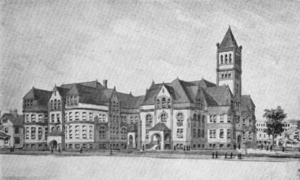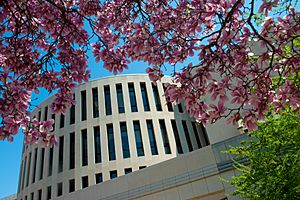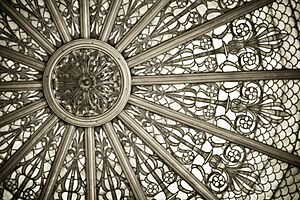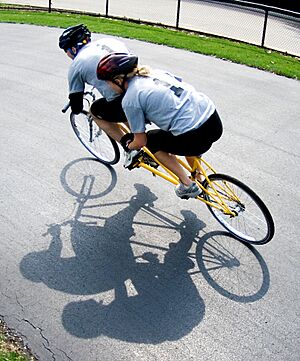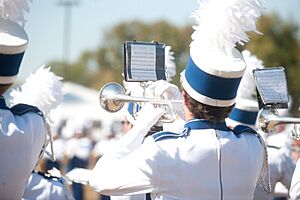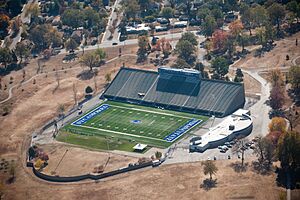Indiana State University facts for kids
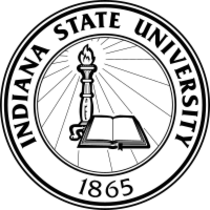 |
|
|
Former names
|
Indiana State Normal School (1865–1929) Indiana State Teachers College (1929–1961) Indiana State College (1961–1965) |
|---|---|
| Type | Public doctoral university |
| Established | 1865 |
|
Academic affiliations
|
Space-grant |
| Endowment | approx. $110 Million (January 2024) |
| President | Mike Godard |
|
Academic staff
|
565 |
| Students | 8,305 (fall 2023) |
| Undergraduates | 6,669 (fall 2023) |
| Postgraduates | 1,636 (fall 2023) |
| Location |
,
U.S.
|
| Campus | Small city, 435 acres (176 ha) |
| Colors | Royal blue and white |
| Nickname | Sycamores |
|
Sporting affiliations
|
NCAA Division I – MVC |
| Mascot | Sycamore Sam |
 |
|
Indiana State University (ISU) is a public university located in Terre Haute, Indiana, USA. It started in 1865. ISU offers more than 100 different study programs for students earning their first college degree. It also has over 75 programs for students who want to continue their education after that. ISU is known as a university that offers advanced degrees, including doctorates.
Contents
History of Indiana State University
Indiana State University began on December 20, 1865. It was first called the Indiana State Normal School in Terre Haute. A man named Chauncey Rose donated $73,000 to help set up the school in Terre Haute.
The main goal of the State Normal School was to train teachers for elementary and high schools. The school started giving out its first bachelor's degrees in 1908. It began offering master's degrees in 1928.
In 1929, the school's name changed to Indiana State Teachers College. Then, in 1961, it became Indiana State College because it was offering more types of studies. Finally, in 1965, the Indiana government officially renamed it Indiana State University. This new name recognized that more students were attending and more degrees were available.
Exploring the Campus
The main campus of Indiana State University is in downtown Terre Haute. It covers more than 200 acres (0.81 km2) in the city's center. The campus has over 60 buildings, including halls and laboratories, mostly made of brick and limestone.
The university has worked to make the campus beautiful. A part of Seventh Street near the university was changed into a boulevard with flowers and old-style lights. An old power plant was replaced with a new one in 2002. Stalker Hall was fully renovated and reopened in 2005. Normal Hall, a classic building from 1909, was also renovated in 2015.
In 2009, a large Student Recreation Center opened. The Bayh College of Education moved into the newly renovated University Hall. The Scott College of Business moved into the renovated Terre Haute Federal Building, an Art Deco building from 1933. The Fine Arts Building was updated in 2019. The Hulman Center sports arena was renovated in 2020 for $50 million. Dreiser Hall was renovated in 2023. In 2024, the Technology Annex building was rebuilt as part of a $66 million project, the largest building project funded by the state for the university.
ISU also has a field campus about 18 miles (29 km) east of Terre Haute, near Brazil, Indiana. This area is used for outdoor teaching, learning, and research. It covers 93 acres (38 ha) and has eight man-made lakes.
Fairbanks Hall: Art and History
Fairbanks Hall is a place for learning and for fine arts performances. It has the Bare-Montgomery Gallery, where students can show their artwork or create art exhibitions.
This building is both an art studio and a gallery for the art department. It was originally built as a public library in Terre Haute between 1903 and 1906. It is a great example of Beaux-Arts architecture and is made entirely from Indiana Limestone.
In 1903, a man named Fairbanks offered to build a new public library if the city provided the land. It was named Emeline Fairbanks Memorial Library after his mother. The building officially opened to the public in August 1906.
In 1978, Indiana State University took over the building. After being renovated, it was named Fairbanks Hall to honor Mr. Crawford Fairbanks, who was a well-known businessman and helped build the original library.
Normal Hall: A Historic Landmark
Normal Hall was built in 1909 and was the university's library for many years. It is the last building remaining from Indiana State's early "Normal School" days. It served as the library until Cunningham Memorial Library was built in 1974.
In 2014–15, Normal Hall underwent a major renovation costing about $16 million. The beautiful grand staircase and a stained-glass dome were restored. The building now meets modern accessibility standards. It was added to the National Register of Historic Places in 2002.
Center for Student Success (CFSS)
The Center for Student Success is located inside Normal Hall. It helps students with many things, like tutoring, mentoring, and academic workshops. It also offers special programs for students with disabilities, first-generation college students, and those with lower incomes.
University Hall: Home of Education
University Hall was built in 1935 with funding from a government project. It first served as a laboratory school. Later, a theater and gymnasium were added. In 2008–09, the building was renovated for $29.8 million. It then became the new home for the Bayh College of Education.
The Bayh College of Education includes many departments and centers that focus on different areas of education, like teaching, counseling, and special education.
Academics at ISU
Students at ISU
In fall 2023, about 29% of students were from minority groups. The top countries for international students were India, Nigeria, and Ghana. Most students come from Indiana, especially from Vigo and Marion counties.
Indiana State was the first public university in Indiana to require new students to have a laptop. The university now provides a laptop computer to students who qualify for certain financial aid.
Colleges and Programs
ISU offers over 100 programs across six main colleges:
- Bayh College of Education (started 1865)
- Donald W. Scott College of Business (started 1918)
- College of Graduate and Professional Studies (started 1961)
- College of Arts and Sciences (started 1962)
- Bailey College of Engineering and Technology (started 1962)
- College of Health and Human Services (started 1963)
Students can earn bachelor's, master's, and doctoral degrees. Many programs are also available online through Indiana State Online.
ISU is part of the College Consortium of Western Indiana. This means full-time students can take classes at other nearby schools like Rose-Hulman Institute of Technology and Saint Mary-of-the-Woods College.
Cunningham Memorial Library
The Cunningham Memorial Library has more than two million items. Students can borrow most materials for three weeks using their student ID.
Accreditation and Quality
Indiana State University has been officially approved by The Higher Learning Commission since 1915. This means the university meets high standards for education. Many of its specific programs, like business, education, psychology, music, nursing, and social work, also have special accreditations from their own professional organizations.
Former Campuses
Indiana State University-Evansville started as a branch campus in 1965. It later became its own independent university, now known as the University of Southern Indiana, in 1985.
Student Media
Student Media at ISU started in 2012. It brings together different student-run media groups. These include:
- The Indiana Statesman: The student newspaper, which dates back to 1895.
- Sycamore Video: Creates videos.
- WISU-FM: A public radio station.
- The Sycamore: A digital yearbook.
- Syc Creations: A group that makes videos and websites for clients.
- Indiana State Sports Network: Produces videos for ESPN3 and ESPN+.
- WZIS: A student-staffed radio station.
University Traditions
Donaghy Day
Donaghy Day is a tradition that started in 1976. It is named after Fred Donaghy, a former student and professor. On this day, students and the community work together to help clean up and beautify the campus and surrounding areas. It is now held at the start of the fall semester to introduce new students to the university's commitment to helping the community.
Homecoming Celebration
ISU's homecoming tradition began on December 15, 1917, as an alumni reunion. Early events included an alumni basketball game. In 1921, "Blue and White Day" started, with various activities. The first student-organized parade, which is now one of the largest in the nation, took place on December 8, 1923. A bonfire and football game were added in 1935. The name "Homecoming" was officially adopted in the mid-1930s.
In 1937, the first Homecoming Queen was crowned. Later, the "Sycamore Court" replaced the Queen and Bachelor of the Year to include more diverse student representatives.
The Sycamore Cup Tricycle Derby, a ten-lap race, was added in 1963. Students rode children's tricycles around the "Quad." Over time, the tricycles became larger and more customized, and the race moved to different locations. Today, the race is held at Recreation East.
The annual Blue and White Dance was a popular formal event. In 1968, it was replaced by Sycamore Showcase, which featured famous performers like Bill Cosby and Bob Hope.
Today, major homecoming events include a campus-wide Blue and White Homecoming Parade, the Sycamore Tricycle Derby, Stompin', a Torchlight Parade, a Pep Rally, Tent City, and the Football Game.
The Walk
"The Walk" is an Indiana State Homecoming tradition that began in the late 1970s. On game day, thousands of students walk two miles east on Wabash Avenue towards the Football Stadium. The university has added programs like "SoberRide" to make the walk safer. The walk happens at the same time as the Blue and White parade in downtown Terre Haute.
Founders Day
Founders Day is celebrated each year in January or February. It remembers the day the university first opened in 1870, when 23 students started classes with three teachers.
University Mascots
The school has had two main mascots. In the early days, athletes were called the "Fighting Teachers." Later, students chose the name "Sycamores" because of the many sycamore trees in Indiana. For a while, a student dressed in a tree costume was the mascot.
In 1969, the university introduced an Indian mascot named Chief Ouabachi and his Princess. This honored the fact that Indiana was named after Native American tribes. However, the university stopped using Chief Ouabachi as a mascot in 1989. For six years, Indiana State did not have a mascot. In 1995, Sycamore Sam, a friendly blue-and-white creature, became the new mascot.
Why "Sycamores"?
In 1921, a contest was held to choose a name for the athletic teams. Before that, they were often called "Fighting Teachers." In January 1922, it was announced that "Sycamores" won the student vote. Indiana State University has used this team name ever since.
Spring Week and Tandem Race
Spring Week started in 1970 as part of the university's 100th anniversary. The main event of Spring Week is the Tandem Race, which is believed to be the only co-ed tandem bicycle race in the country. Today, Spring Week is the biggest all-campus event in the spring. It includes community service, educational activities, and competitions for students.
Tandem teams are made up of campus organizations, with 10 male and 10 female riders, plus two alternates.
The first tandem race in 1970 had 25 laps around a course in Fairbanks Park. Over the years, the race moved to different locations, including the Wabash Valley Fairgrounds and city streets. In 2000, the race moved to the new track at the Recreation East Facility on campus.
In 2005, the Michael Simmons Activity Center was added to the Recreation East complex. This building helps officials score the race and provides bleachers for fans to watch.
Blue and White Colors
In 1899, the university's official colors became Yale Blue and White, replacing Salmon Pink and White. These colors are also used for the Blue and White Parade and the Blue and White Dance during Homecoming.
Book and Torch Symbols
The book and torch are official symbols of the university and are on its seal. The book stands for knowledge and truth gained at the university. The torch represents the light of inspiration that students find there.
Book and Torch Ceremony
This traditional ceremony marks the senior class's commitment to becoming active alumni of Indiana State. It happens twice: once on Founder's Day (usually in January) and again at graduation. During the graduation ceremony, the senior class accepts the challenge to stay connected to the university as alumni.
Trike Race
The Indiana State Tricycle Derby first took place in 1963. It was a 10-lap race around the sidewalks of the Quadrangle using children's tricycles. There were separate races for men and women. Today, men's and women's teams race on specially built tricycles at the new Recreation East complex. In 2005, the Michael Simmons Student Activity Center opened at Rec East, providing seating for fans and displays about the history of the trike and tandem races.
University Songs
Fight Song
The university's fight song is "March On! (You Fighting Sycamores)". It was written by Joseph A. Gramelspacher, an ISU music professor, and first performed at a pep rally on October 20, 1939. Before "March On!", the school's fight song was "Cheer for the Blue and White", composed in 1931.
The School of Music has many groups for students, including The Marching Sycamores, Concert Band, Jazz Ensembles, University Symphony, and various choirs.
Alma Mater
The university's alma mater, a song honoring the school, was written by Charles M. Curry, an English professor. It was first published in 1912 and uses the music of "Annie Lisle".
Athletics at ISU
The school's sports teams are called the Sycamores. They compete in NCAA Division I in the Missouri Valley Conference for most sports, and in the Missouri Valley Football Conference for football.
Indiana State is known for famous athletes like basketball player Larry Bird, gymnast Kurt Thomas, and wrestler Bruce Baumgartner. Basketball coach John Wooden also coached the Sycamores before going to UCLA.
The men's basketball team started in 1896, making it one of the oldest teams in the NCAA. They won the 1950 NAIB National Championship and were runners-up in 1946, 1948, 1968 (Division II), and 1979 (Division I). The 1950 team also formed the core of the 1951 Pan-American Gold Medal Team. In 1971, the women's gymnastics team was National Runner-up. Kurt Thomas led the Men's Gymnastics Team to the 1977 NCAA National Championship.
Sports Facilities
Hulman Center is a large arena that opened in 1973. It holds 10,200 people for basketball and is home to the men's and women's basketball teams. It has hosted many concerts and important basketball games, including the 1979 Missouri Valley Conference men's basketball tournament title game, when Larry Bird helped the undefeated Sycamores reach the NCAA tournament championship. The Hulman Center was renovated for $50 million and reopened in December 2020.
The baseball field, Bob Warn Field at Sycamore Stadium, is near campus. It has hosted the Missouri Valley Conference Baseball Championship multiple times. Memorial Stadium, home to the football and women's soccer teams, is two miles (3 km) east of campus. The Gibson Track and Field Complex is a newer facility by the Wabash River. Price Field is home to the Sycamore Softball team.
Indiana State University has hosted the NCAA Division I cross country championships many times at the LaVern Gibson Championship Cross Country Course. It has also hosted other NCAA cross country championships and high school track and field championships.
Men's Sports
- Baseball – Bob Warn Field at Sycamore Stadium
- Basketball – Hulman Center
- Cross country – LaVern Gibson Championship Cross Country Course
- Football – Memorial Stadium
- Track and field – Gibson Track and Field
Women's Sports
- Basketball – Hulman Center
- Cross country – LaVern Gibson Championship Cross Country Course
- Soccer – Memorial Stadium
- Track and field – Gibson Track and Field
- Softball – Price Field at Eleanor Forsythe St. John Softball Complex
- Golf – various local courses
- Volleyball – ISU Arena
- Swimming – Vigo County Aquatic Center
Notable People from ISU
Many successful people have studied or worked at Indiana State University.


